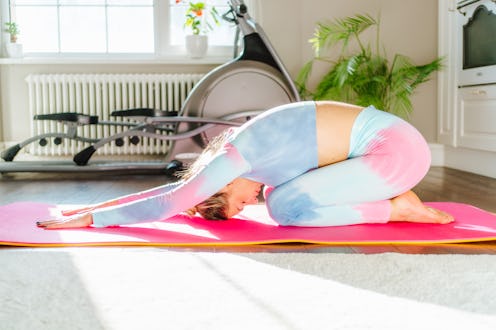Fitness
Why Child's Pose Is The Ultimate Lazy Girl Stretch
Zero effort, tons of benefits.

Yoga can look like a sweaty, hour-long workout — or it can look like a handful of easy poses that you melt into while watching TV. You can’t go wrong either way, but you might prefer one over another depending on your mood. If you feel like doing the least, child’s pose is always a good posture to drop into, especially if you’re stressed.
Child’s pose, or balasana, is a yoga pose that involves kneeling with your torso folded forward and your arms extended or alongside your body, says Jenni Hackworth, RYT-200, a yoga teacher and certified personal trainer. If you feel up to it, you can get deeper into the posture by resting your forehead on the mat or with your head to one side. In short: It’s all about chillaxing on the floor.
“Child's pose is considered a restorative or gentle pose, which means it is not physically demanding — but that doesn't mean it's not good for you,” Hackworth tells Bustle. “Passive or ‘easy’ poses are still beneficial because they can help you release tension and promote relaxation in the body and mind. They’re also a good starting point for beginners who are still developing their flexibility and strength.” Whether you want a mid-day break, a pre-bed stretch, or you’re craving a moment of Zen, it’s always a good time to slide into child’s pose. “It’s a great way to take a break from more active yoga postures to focus on breathing, relaxation, and gentle stretching, too,” Hackworth says. (This is why many yoga instructors say you can always take a beat in child’s pose mid-vinyasa flow.) And, according to Anja Brierley Lange, a yoga teacher and author, the pose is also easy to modify, which is great if you want to mix it up for utmost comfort.
Here’s everything to know about child’s pose, the ultimate lazy-girl stretch.
How To Do Child’s Pose
A step-by-step guide to doing child’s pose:
- Start on your hands and knees.
- Sit your hips back onto your heels.
- Fold forward over your thighs.
- Reach your arms forward.
- Slowly lower your forehead to the floor.
You could also modify it by doing the following:
- Rest your arms by your sides or bend them in front of you to create a place to rest your head.
- Spread your knees apart for a simpler stretch and to create more space for your abdomen and chest.
- Add a yoga block to support your forehead.
- Tuck your toes under and put a rolled-up blanket under your ankles for support.
- If your seat doesn’t touch your heels, put a cushion between your calves and butt to adjust and relieve knee pain.
Benefits Of Child’s Pose
Child’s pose is right up there with savasana, or corpse pose, when it comes to its relaxation factor. While it may be passive, it has a lot going for it. According to Hackworth, simply resting your head on the ground can promote relaxation and reduce feelings of anxiety and overwhelm — so child’s pose is super helpful whenever you have racing thoughts.
According to Brierley Lange, the position of the stretch makes it easier to take deep breaths, especially if you create space between your knees for your diaphragm to expand. “Most forward bends calm the mind, but with this one, there is no muscular engagement,” she says. Because of that, you can truly relax in this position.
Child’s pose is a great posture to hang out in when you want to breathe and unwind, but it’s also a great stretch. The arm reach is an ideal way to open up your back, neck, and shoulder muscles — all areas that commonly hold onto stress and tightness, Hackworth explains. After breathing into the pose, things should loosen up.
The forward fold also does wonders for your lower body. “Child's pose will gently stretch the muscles of the [lower back] and thighs, which can help improve spinal alignment and relieve back pain,” Hackworth adds. “The pose can also help stretch and release tension in the hips, which can be especially beneficial for people who sit for long periods or have tight hip flexors.” All in all: The chill pose really does the most.
Studies referenced:
Albracht-Schulte, K. (2018). The effects of yoga and quiet rest on subjective levels of anxiety and physiological correlates: a 2-way crossover randomized trial. BMC Complement Altern Med. doi: 10.1186/s12906-018-2343-1.
Cramer, H. (2018). Yoga for anxiety: A systematic review and meta-analysis of randomized controlled trials. Depress Anxiety. doi: 10.1002/da.22762.
Sources:
Jenni Hackworth, RYT-200, yoga teacher, certified personal trainer
Anja Brierley Lange, yoga teacher, author